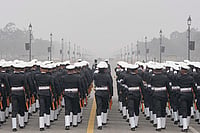
Lloyd lifts ’75 WC trophy. Getty Images, From Outlook, February 21, 2011)
Ale and Hearty
- Former England captain Tom Graveney surely loved his ale more than cricket. He was the adjudicator in a thriller the West Indies and Pakistan played for a place in the semis in 1975. With the West Indies tottering at 203/9, and believing the game was to end soon, Graveney left for the bar to get a drink—but lingered around to drink a few. In his absence, Deryck Murray (61*) and Andy Roberts put on 64 runs to win the game. Graveney sauntered out and promptly named Pakistan’s Sarfraz Nawaz the man of the match. Murray remembers Graveney’s explanation: “It is normal for a player from the winning team to get the award.” Someone then told Graveney that Pakistan had lost—but his decision stood.
A Car Too Far
- Malcolm Marshall, the great West Indian, bowled frighteningly fast—and loved faster cars. Playing his first World Cup in 1983, at the height of his career, he had no doubts about who would win: the West Indies, obviously. Seeing India reach the final, his confidence soared. He promptly put down a deposit on a nice BMW car—the rest of the money would be, of course, paid with the winner’s cheque soon after June 25, the day of the final against India. After the shocking loss, Marshall lay on the field, crying for his team—and perhaps for his dream car too.

Marshall, Walsh in ‘Pak dress’
Carpet Bagger
- Courtney Walsh was a gentleman cricketer, but at Lahore in 1987, was his very proper behaviour against Pakistan prompted by fear? It went like this: the scores were tied, he was about to bowl the last ball, and Pakistan last man Salim Jaffer backed up too far at the non-striker’s end. Walsh could have run him out but did not—he only warned Jaffer. Abdul Qadir then struck the winning runs. President Gen Zia-ul-Haq gifted Walsh a carpet for playing the game the gentleman’s way. Cynics, however, suggested that if Walsh had indeed run Jaffer out, he’d have needed a magic carpet to flee Pakistan.

England vs SA, 1992 semis
Rain the Bane
- Those who curse the mysterious Duckworth/ Lewis method should talk to the South Africans, who had a chance to reach the final of the World Cup in 1992—but a bizarre rule did them in against England in the semis. With 13 balls to go, they needed a gettable 21 runs when rain caused a short break. Back on the field a little later, with the target revised according to the existing method then, their batsmen were disgusted to find an impossible equation confronting them—21 off one ball.
Rain Again
- The rain rule worked against India too in their 1992 World Cup match against Australia at Brisbane, though No. 11 Venkatapathy Raju too contributed through his stupidity. After the rain had cut time and made their target stiffer, India needed four off the final ball, one wicket in hand. Javagal Srinath lofted the ball, and Steve Waugh dropped the catch at the boundary. Last man Venkatapathy Raju, thinking it was a four, was celebrating rather than running, wasting precious moments. Waugh stopped the ball, fired it back and Raju was run out attempting the third run which would have tied the game. A furious Srinath charged the hapless Raju as the players came off.
Getting Their Sums Wrong
- You need to master arithmetic to get the Duckworth/Lewis method of calculation right. Take the South African team of 2003. In their must-win first round match against Sri Lanka at Durban, the hosts were 216/6 in 44 overs when the rain became intense and a stoppage was imminent. The wise men in their dressing room got the D/L calculations out and a message was sent in to the batsmen that they needed 13 off the next over to reach the D/L target of 229 in 45 overs. Mark Boucher hit the fifth ball for a six, taking the score to 229, and punched the air in jubilation. He then defended the final ball. But soon SA was in mourning: the victory target was actually 230, 229 just ensured a tie and knocked them out.

Illustration by Sorit
Survival of the Fattest
- Bermuda, playing their first World Cup in 2007, were the smallest nation ever to be on cricket’s world stage with a population of just 66,000. But their left-arm spinner Dwayne Leverock loomed very, very large in the field. At over 120 kg, he is the heaviest cricketer in World Cup history, and also a large walking billboard to advertise Indian food. He explained his chubbiness by saying he lived above an Indian restaurant, “and there’s another one next door!”

Sultan Zarawani hit by Donald in ’96
Sultan of Swing
- Sultan Zarawani, the lone native-born player in UAE’s sole World Cup appearance in 1996, seemed to have everything—including a dozen luxury cars. What he lacked was sense: he came out to face South Africa’s fearsome fast bowler Allan Donald at Rawalpindi with no helmet on. That was like waving a red rag to a bull and, sure enough, Donald struck him on the head first ball. Zarawani was out six balls later for a duck. To add insult to injury, Donald in his autobiography White Lightning called him ‘Sultan Hirwani’, confusing him with the Indian spinner.

Photograph by Patrick Eagar
Sunny Daze
Long before India discovered Tendulkar and Sehwag, there was Sunil Gavaskar, immaculate in technique, rarely ever in a hurry. Not even when India was chasing England’s mammoth 334/4 from 60 overs on the opening day (June 7, 1975) of the inaugural Prudential World Cup. India crawled to 132/3; the snail of snails was Gavaskar, scoring an unbeaten 36 from 174 balls. Tony Lewis was to later describe Gavaskar’s agonising innings as “Indian mysticism which defied explanation”. The Indians in the crowd were livid—one dumped his lunch at Gavaskar’s feet, another assaulted two policemen and was jailed for six months! Sunny’s own explanation: I had a mental blackout. About scoring, obviously.
Gulu Ezekiel is the author of numerous sports books including a history of the World Cup






















